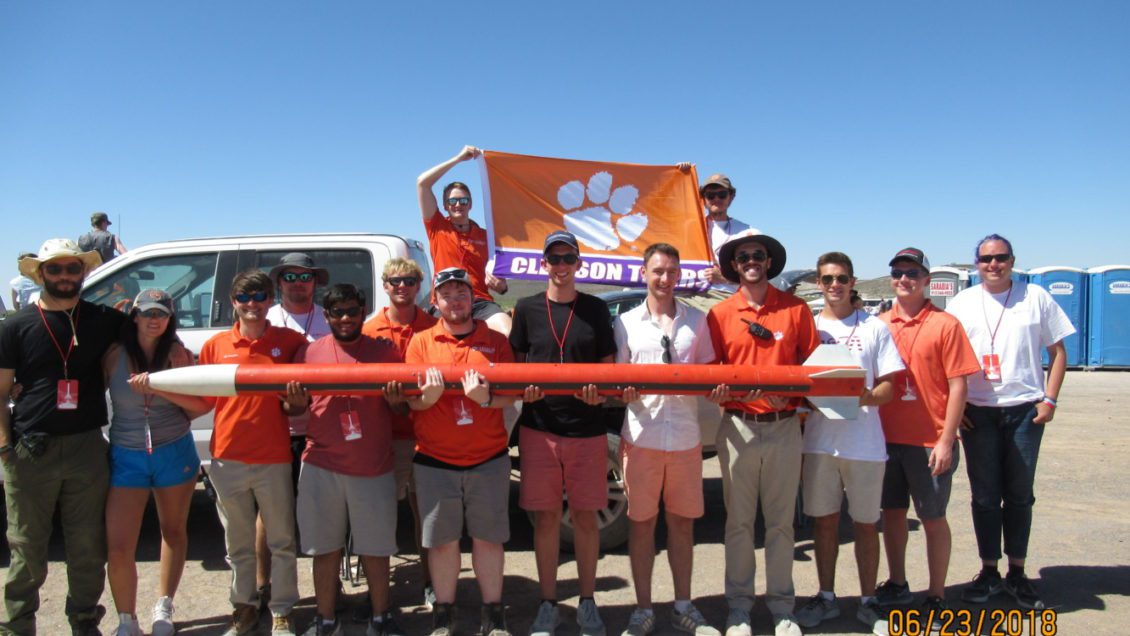CLEMSON — Imagine if the Clemson Tigers played for national championships in football and basketball in the same week, or maybe even the same day.
That’s what the excitement level will be like next week for several Clemson University students who plan to blast a rocket about 30,000 feet above the New Mexico desert while closely watching a separate launch on the Virginia coast that will shoot their robotic tentacle into space.
The big week starts Saturday when about 20 students from the Clemson Rocketry Team pile into vans and head for Spaceport America about an hour outside Las Cruces, New Mexico, where they will launch a rocket they designed and built as part of the Intercollegiate Rocket Engineering Competition or IREC.
[vid origin=”youtube” vid_id=”D_6FouqCGvs” size=”medium” align=”right”]
If all goes as planned, the rocket will hit 800 mph, breaking the sound barrier as it climbs to about the same height as Mount Everest. A parachute will deploy and the rocket will float gently back to the desert below, students said.
In the same week, a suborbital sounding rocket is scheduled to launch into space from NASA’s Wallops Flight Facility in Virginia. The expected payload includes a “soft robotic tentacle” designed and built by students from Clemson’s Small Satellite Team.
Months of hard work will be on the line as rockets soar into the heavens on opposite ends of the country.
Excitement was building as launch week neared. Since final exams ended last month, students have been pulling 12-hour days in the Cook Engineering Laboratory on campus, soldering circuit boards and machining rocket parts.
Among the hard-working students is Charles Dove, who founded the satellite team and is head of avionics for the rocketry team. Dove has watched several launches and he’s looking forward to returning to New Mexico for this year’s competition.
It’s incredible, he said, to watch something he helped build blast off into the wild blue yonder.
“When you all work on something like that, it’s bigger than if you just did something yourself,” Dove said. “We’re all bunched up together watching this thing go off. The electricity in the air is palpable.”
The two teams are closely related. About 50 undergraduates are on the Clemson Rocketry Team. Eight of the rocketry team’s most interested members, including its president, Charles Black, compose the Small Satellite Team.
Launch dates will depend on weather, but it’s possible both of the Clemson launches will happen on the same day. IREC launches are scheduled from June 19-22, and the Virginia launch is set for June 20.
This year will mark the rocketry team’s third showing at IREC but will be its first time shooting for 30,000 feet. In the first two years, the team competed in a 10,000-foot category.
As part of the competition, students try to predict the rocket’s apogee — its highest point — and come as close as they can to it. Teams are also judged on their technical reports and design implementation.
The Clemson team last year predicted an apogee of 10,385 feet and hit 7,311. The team placed in the top half overall and took first place for landing its rocket closest to the launch pad, Black said.
The team started with about 12 members in 2016 and has grown fast, he said. What Black likes best about rockets is seeing his team succeed.
“It’s super rewarding,” Black said. “Last year, I went up in the tower and pressed the button. I looked up, then looked down and saw 20 people going crazy. That was awesome.”
In the Virginia launch, the Small Satellite Team’s mission will be to analyze and manipulate its tentacle, also called an actuator, under the high-stress conditions of space flight.
“Essentially, we’re testing the effects of the high-gravity environment of a rocket,” Dove said. “When this thing takes off, there are a lot of G’s that are pulled. So we’re testing the effects of that on a soft robotic actuator, which essentially is a special kind of robot.”
The robot is good at grasping things without doing damage and could be helpful on the International Space Station, he said. It’s among nine student projects from across the country that are set to launch as part of the Colorado Space Grant Consortiums’ RockSat-C program.
Also as part of the program, the Small Satellite Team developed an eight-week curriculum that it took to Midway Elementary School in Anderson to teach students about about electronics, space and space exploration, Dove said.
Most of the students involved in the rocketry team are majoring in mechanical engineering, electrical engineering and computer science, Black said.
Dove recently received the W.M. Riggs Award, an honor that goes to the most outstanding senior in electrical engineering, and accepted a plaque from Daniel Noneaker, chair of the Holcombe Department of Electrical and Computer Engineering.
Black is a senior majoring in mechanical engineering and plans to pursue his master’s degree in aerospace propulsion at Purdue University after graduating from Clemson.
Things are looking up for the teams literally and figuratively.
The rocketry team is looking to continue its expansion and possibly start a propulsion team that would make its own rocket fuel, which would create new opportunities for chemical engineering majors, Black said. The team is also working to start a business division with students majoring in finance, communication and accounting, he said.
“The more multidisciplinary we can get, the better,” Black said.
Get in touch and we will connect you with the author or another expert.
Or email us at news@clemson.edu

